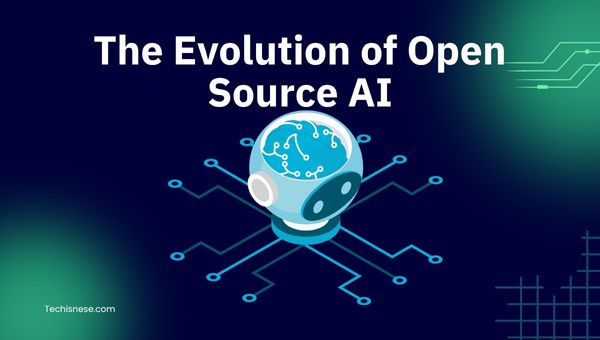
In the fast-evolving world of artificial intelligence, the phrase “open source AI” is everywhere. But what is open source AI, and why is it making headlines across the tech industry? Whether you’re a developer, a business leader, or just curious about the future of technology, understanding open source AI is essential for staying ahead in today’s digital landscape.
This article dives deep into what open source AI really means, how it works, its advantages and drawbacks, and why it’s at the center of debates about transparency, innovation, and control. If you’ve ever wondered how open-source AI could change the way we build and use intelligent systems, keep reading because the answers might surprise you.
Open source AI refers to artificial intelligence systems whose core components—such as source code, datasets, model weights, and parameters—are made freely available for anyone to use, study, modify, and share.
This approach is rooted in the same philosophy as open-source software, granting users the fundamental freedoms to:
To qualify as open source AI, all these freedoms must be granted not only for the software code but also for the AI models, training data (where legally and ethically possible), and other essential elements.
Open source licenses—such as the Apache License, MIT License, and GNU General Public License—typically govern how these resources can be accessed and redistributed.
Open source AI breaks down barriers by making AI tools accessible to all. It accelerates innovation through community collaboration, enhances transparency by exposing AI inner workings, and supports education by providing resources for learning.
This openness is crucial for ethical AI development and widespread adoption.
Also Read: What Does AI Inference Mean?
Open source AI offers freedom to use, modify, and share, while closed source AI is proprietary and controlled by a single entity. Each has pros and cons regarding accessibility, transparency, security, and cost. Understanding these differences helps users choose the best fit for their needs.
| Feature | Open-Source AI | Closed Source AI |
|---|---|---|
| Accessibility | Freely accessible to everyone | Restricted, proprietary access |
| Modification | Anyone can modify and improve | Only the owner can change the system |
| Transparency | Full transparency of code and models | Opaque, limited insight |
| Innovation Speed | Rapid, community-driven innovation | Slower, internal development |
| Security | Open to public review, but potentially more vulnerable to misuse | Controlled, but less scrutiny |
| Support | Community-driven, may lack formal support | Vendor-provided, often with SLAs |
| Cost | Usually free or low-cost | Often expensive licensing |
| Licensing | Open source licenses (Apache, MIT, GPL, etc.) | Proprietary licenses |

Open source AI has gained momentum with the rise of generative AI and large language models (LLMs). According to industry reports, two-thirds of LLMs released in 2023 were open source, reflecting a shift toward collaborative development3. Major tech companies like Meta, Amazon, and NVIDIA have contributed open source AI tools, making the technology more accessible and competitive.
However, the definition of “open source AI” is still evolving. Some companies have been accused of “openwashing”—marketing their AI as open source while imposing significant restrictions on its use or distribution.
This has led to new efforts, such as the Open Source Initiative’s Open Source AI Definition, to clarify what truly constitutes open source AI.
Open source AI promotes transparency, enabling safety audits and bias detection. It encourages collaboration, reduces costs, and allows customization. These benefits empower diverse users to innovate and adapt AI technologies, fostering a more inclusive and competitive AI ecosystem.
Also Read: What is Surgical Technology?
While open source AI offers many advantages, it also faces challenges like security vulnerabilities, inconsistent quality control, limited formal support, and legal restrictions on data sharing. These issues require careful management to ensure responsible and effective AI deployment.
Open source AI powers applications such as language models, translation tools, chatbots, and computer vision systems. It supports research, education, and industry innovation, demonstrating its versatility and growing impact across multiple sectors worldwide.
A major challenge in the open source AI movement is defining true openness. Some organizations release models with significant restrictions, such as limitations on commercial use or redistribution, which contradicts the core principles of open source.
The Open Source Initiative and other groups are working to standardize definitions and combat “openwashing” the practice of labeling restricted software as open source for marketing advantage.
A: Open source AI includes not just code, but also models, data, weights, and parameters. All these elements must be accessible and modifiable under open source terms.
A: Yes, as long as the license permits it. Most open source licenses allow commercial use, but it’s important to check the specific terms.
A: Like any technology, open source AI can have security or quality risks, especially if models are not well maintained or if bad actors exploit open access.
Open source AI is reshaping the artificial intelligence landscape by making powerful tools and models accessible to everyone. By promoting transparency, collaboration, and rapid innovation, open source AI is driving the next wave of technological progress.
However, it also brings challenges around security, quality, and the true meaning of “openness.” As the debate continues, one thing is clear: open source AI will play a central role in the future of intelligent systems.
If you want to stay at the forefront of this revolution, keeping up with what is open source AI is more important than ever.